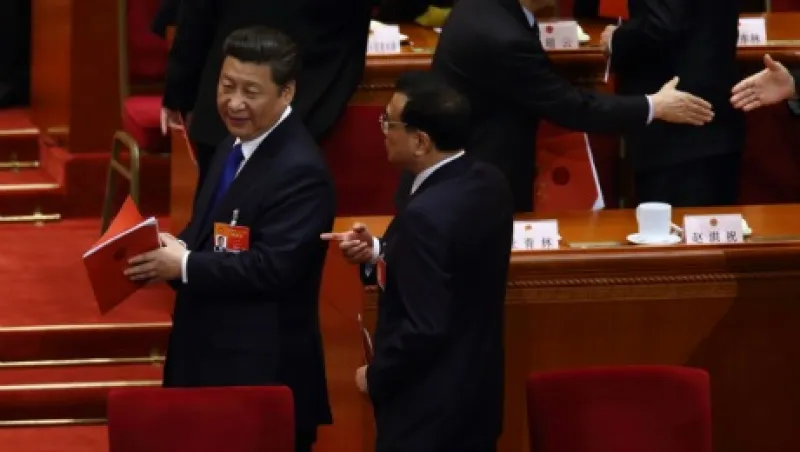For nearly a decade and a half, there has been an annual spring ritual in Beijing. At the close of the National People’s Congress in March, journalists from around the world crowd into the Great Hall of the People for the premier’s yearly press conference, awaiting his announcement of China’s projected growth rate for the year. From that moment forward, markets rock or rattle.
It seems that the world’s media and politicians have come to believe that global economic salvation depends on whether or not China can sustain its hypergrowth. This belief has become so ingrained that investment analysts and talking heads have been blaming the unpredictability of U.S. markets on the slowdown in China. Within an hour’s worth of testimony in September, Federal Reserve chair Janet Yellen alluded to China 16 times, including singling out “intensified uncertainty about China’s exchange rate policy and prospects for its economy” as the root cause of U.S. volatility.
For analysts sitting on the edge of their chairs awaiting news of a China growth rate rebound, I have got some bad news for you. China’s leadership wants to rebalance growth, not accelerate it. Got it? It is not about China’s economy slowing. It is about the necessity of slowing it.
Let us look at the reason why 8 percent growth as a threshold for China’s economy came to exist in the first place.
At the National People’s Congress press conference in March 1998, China’s first economic czar, former premier Zhu Rongji, promised a set of three guarantees: no less than 8 percent growth, no more than 3 percent inflation and stabilization of the yuan. This cocktail was mixed to ensure re-employment of blue-collar workers laid off from state-owned enterprises in the midst of the Asian financial crisis. It was a specific formula for a specific task at a specific time. It was never intended to be a fixed litmus test of China’s economic health or stability.
“Blind growth” was something Zhu adamantly warned against. But Wen Jiabao, the following premier, changed all that. Determined to excel his predecessor, Wen kicked off his term in 2003 by upping the growth rate to 9 percent and then on to double-digit growth in the massive infrastructure spending spree in the run-up to the 2008 Beijing Olympics. Regional officials and cadres were promoted on the basis of one thing alone: growth. Fixed-asset investment, especially in construction, drove a surge in economic expansion that fueled consumption of resources, boosted global commodity prices and ruined China’s environment.
Wen’s mantra was that political and social stability could only be ensured if growth exceeded 8 percent a year. In the view of his administration, destruction of the environment was merely an inevitable by-product of development. Investment analysis grew fixated on China’s annual growth rates, which soon became a global benchmark for domestic economic expansion.
In the meantime, the skies became so polluted that unbreathable toxic air quality is common in many Chinese cities. Some 60 percent of China’s underground water became too polluted for drinking, and 70 percent of its surface water too toxic for human contact. Using this water for crops affected agriculture. Soon China was facing a water, food and health security crisis.
At the outset of Wen’s administration, China faced some 80,000 domestic protests or riots each year. By the time he stepped down, the figure had risen to approximately 150,000, most caused by anger over environmental desecration and ensuing health costs.
In 2012, as Xi Jinping took to the stage as president of China, with Li Keqiang as premier, they faced a new challenge: Not how to rocket growth but, rather, how to curb it?
To tackle the problem, I was called in and asked to serve as senior adviser to China’s Ministry of Environmental Protection in drafting the policy blueprint for ecological civilization. I previously had served under Zhu’s administration, having advised on state-owned enterprise restructuring and reemployment of workers who had been made redundant. The core issues that China faced in 1998 and 2013 were very different. New formulas were needed.
The core issue at hand was growth. I argued that China’s double-digit growth was an illusion. The costs associated with repairing the environment, along with food-and-water security and health care, offset the boost in GDP. To move forward, China would need to rebalance growth through a transition from fossil fuels to renewable energy, regridding cities, investing in smart transportation, rehabilitating the environment and conserving water. All this would require fixed-asset investment from the state and private sector — creating new jobs and opening opportunities for new technology. Soon Premier Li was using language like “elasticity of growth,” and President Xi was calling for “ecological growth.”
I led the drafting of a policy document titled “Opinions Toward Promoting the Construction of Ecological Civilization.” Adopted by the State Council and China’s Communist Party Central Committee on April 25, 2015, it is critical in understanding China’s new approach to managing the macroeconomy.
Article 25 of the document rejects promotion of officials based on economic growth: “We should cancel regional GDP assessment ... Entities and individuals that have made outstanding achievements in development of ecological civilization should be commended and awarded. We should ... audit the natural resource properties and environmental responsibilities for leaders leaving their posts.”
Article 2 rejects World Bank advice that China needs debt-leveraged spending to create a consumption-driven economy: “We should adhere to the principle of giving high priority to conserving resources protecting the environment and promoting its natural restoration ... with minimal resource consumption.”
As the National People’s Congress convenes in Beijing, the Western media will be left pondering how China will meet its growth targets. The real challenge for Xi and Li, however, is how to make China’s economy healthy, rather than just big.
Laurence Brahm is an international lawyer, mediator and economist and has served as senior adviser to China’s Ministry of Environmental Protection.






